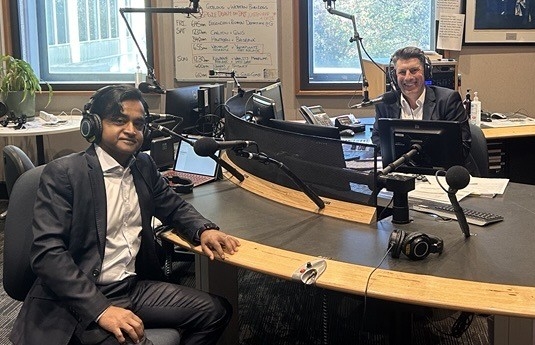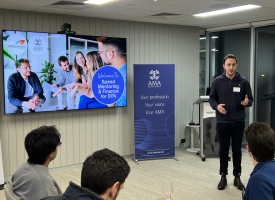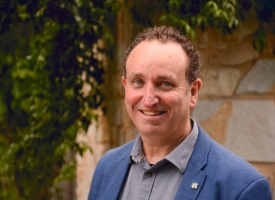Transcript: ABC Radio Adelaide - New AMA SA President
New AMA SA President Associate Professor Peter Subramaniam says he is focused on strengthening workforce resilience as the foundation for addressing South Australia's ongoing healthcare challenges.

Transcript: AMA SA President Associate Professor Peter Subramaniam on ABC Radio Adelaide with Rory McClaren.
(23 May, 2025)
Subjects: workforce sustainability, workforce planning, leadership, unity
Rory McClaren: There's new leadership at the Australian Medical Association in South Australia as Dr. John Williams' tenure comes to an end. The new head is Associate Professor Peter Subramaniam. He joins me now in the studio. Peter, good morning and congratulations.
Associate Professor Peter Subramaniam: Good morning, Rory, and good morning to your listeners.
Rory McClaren: For those who may not know you, what’s your background in medicine?
Associate Professor Peter Subramaniam: I’m a vascular surgeon and have been practicing for about 25 years. I started at the Queen Elizabeth Hospital in 2001 and now work at the Royal Adelaide Hospital, which is part of the Central Adelaide Local Health Network. I also run a private practice and have operated in Adelaide’s private hospitals throughout that time. Additionally, I serve the people of the Riverland—one of my favourite trips each month is driving to Berri to see and operate on patients, and enjoy the beautiful River Murray. That’s me in a nutshell.
Rory McClaren: You’re stepping into this role at a time when healthcare workers are under immense pressure. What immediate steps do you think need to be taken to support the medical workforce across the state?
Associate Professor Peter Subramaniam: Having served as Vice President under Dr. John Williams, I’ve had time to reflect on the priorities for my tenure. Access to care is a major issue—whether you call it ramping or system demand, it’s a persistent challenge. My focus is on ensuring we have a strong and stable medical workforce. No matter how many hospitals or beds we build, they won’t be effective without the right people to staff them.
Rory McClaren: Does that include workforce planning?
Associate Professor Peter Subramaniam: Absolutely. Workforce resilience isn’t just about solving today’s problems—it’s about building a pipeline of future doctors. Healthcare is evolving, and with an ageing population, demand is only increasing. We mustn’t lose sight of long-term, strategic planning.
Rory McClaren: What are the key long-term issues for you?
Associate Professor Peter Subramaniam: The main issue is ensuring we have the right number of doctors in the right places. The government has added around 680 doctors since March 2022, but we’re still facing a health crisis, including persistent ambulance ramping. This isn’t a problem with a single solution—it requires a system-wide approach. We also need to attract and retain doctors in South Australia.
Rory McClaren: On that note, where do wages come into play, especially in the public sector?
Associate Professor Peter Subramaniam: While the Australian Medical Association doesn’t perform an industrial function in South Australia, we absolutely have a view. A settled and supported workforce leads to better healthcare. Competitive wages and conditions are essential to attracting and retaining doctors, and we support strategies that strengthen the workforce.
Rory McClaren: You work across both public and private sectors. Where do you see the biggest disconnects, and how can the Australian Medical Association help bridge those gaps?
Associate Professor Peter Subramaniam: The private system is also under pressure. We’ve seen closures and operational challenges in private hospitals. The recent $60 million development at Burnside is a positive step—expanding private capacity can relieve pressure on the public system. But rebates for private hospitals must be maintained, and that’s a national issue the Australian Medical Association is advocating on.
Rory McClaren: The Australian Medical Association has also raised concerns about vertical integration. Can you explain what that means in a medical context?
Associate Professor Peter Subramaniam: Vertical integration is when insurers also provide care. In the U.S., it’s called managed care. While it can be useful in some contexts, in Australia it risks reducing patient choice. Doctors should be able to make decisions based on what’s best for the patient—not what’s dictated by a payer who owns the facility. It raises ethical concerns that we need to consider carefully.
Rory McClaren: We’ve had a lot of texts from allied health workers. One asks: how can ramping improve without enough occupational therapists and allied health professionals to discharge patients?
Associate Professor Peter Subramaniam: That’s a very valid point. Healthcare is a team effort. While my role is to represent doctors, we fully acknowledge the need for adequate allied health, nursing, and administrative staff. One takeaway from our recent roundtable was that everyone—doctors, nurses, allied health—wants to do their job as effectively and directly as possible. We need a system that supports that.


